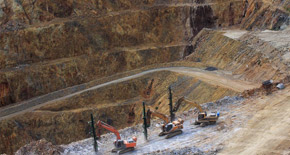Exploring Subterranean Landscapes with Stream DP
Mapping Northern Hairy-Nosed Wombat Burrows with Ground Penetrating Radar

In a collaboration between the Australian Wildlife Conservancy (AWC) and the Wombat Foundation, Subsurface Mapping Solutions (SMS), in conjunction with C.R.Kennedy, applied GPR technology at the Richard Underwood Nature Refuge in Wycombe - Australia, to map the burrows of the critically endangered northern hairy-nosed wombat.
Conservation in Practice
The northern hairy-nosed wombat, the world’s largest burrowing herbivore, is facing an imminent threat of extinction. In an effort to aid the survival of this species, the conservation team has recognised the importance of mapping the wombat’s burrows. This is where a GPR array solution that emits pulsating radio waves underground while passing over the grassy scrub came in.
To delineate and detect the intricate burrows, SMS used IDS GeoRadar Stream DP, a multichannel GPR array redefining standards for subterranean surveys. The team did the analysis and post-processing in IQMaps, a new post-processing software application for advanced GPR data analysis, which provides a fast interface between the user and the GPR data. Established in 2020, SMS initially focused on utility consulting and project management, specialising in addressing challenges related to underground utilities. Utilising cutting-edge technology, the company ensured the efficient acquisition and delivery of crucial data for various projects. SMS recently expanded its services, venturing into uncharted territories by accepting the challenge of mapping intricate burrows of endangered creatures.
This diversification highlights how advanced technology can be harnessed for conservation efforts, exemplified by the recent mapping of wombat burrows. Consequently, data output was created in PDF, video flythrough, and BricsCAD format, along with tomography photos in ten-centimetre increments to a depth of 2.5 meters. Stream DP’s Equalized Scrambled Technology (EsT) optimises the antenna’s radiating potential, ensuring superior noise rejection and capturing a broad frequency range. This innovation results in an extended depth range and ultra-high resolution, mitigating the traditional trade-off between depth and clarity.
The exceptional performance of Stream DP positions it as a preferred solution for locating buried objects at significant depths, making it the best tool to map labyrinthine tunnels such as the Northern Hairy-Nosed Wombat burrows.
Diversifying from utility consulting to conservation Mapping.
Established in 2020, SMS initially focused on utility consulting and project management, specialising in addressing challenges related to underground utilities. Utilising cutting-edge technology, the company ensured the efficient acquisition and delivery of crucial data for various projects. SMS recently expanded its services, venturing into uncharted territories by accepting the challenge of mapping intricate burrows of endangered creatures. This diversification highlights how advanced technology can be harnessed for conservation efforts, exemplified by the recent mapping of wombat burrows.
Convergence of GPR Technology and Conservation.
The noteworthy capabilities of the Stream DP, powered by EsT technology, extend beyond urban landscapes, contributing to the preservation of habitats and futures of species like the northern hairy-nosed wombat. This collaborative project underscores the potential of innovation in achieving shared commitments to biodiversity conservation, one burrow at a time.
Looking forward, the commendable efforts of Subsurface Mapping Solutions and their collaborators in conserving the northern hairy-nosed wombat emphasise that technology can serve as a valuable tool for safeguarding vulnerable species. By harnessing the power of GPR innovation, there is potential to redefine the narrative surrounding endangered species, contributing to a more sustainable future for all living beings.
A version of this article initially appeared on C.R. Kennedy, Geospatial Solutions Website.
Download the Use Case.




























